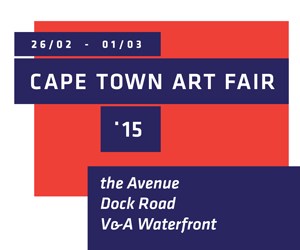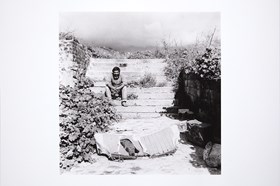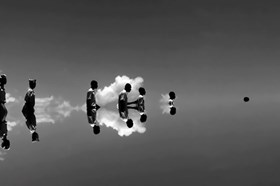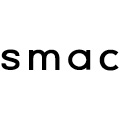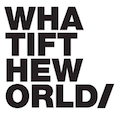artthrob picks
Cape Town's Art of Short Sightedness
By M Blackman on 18 November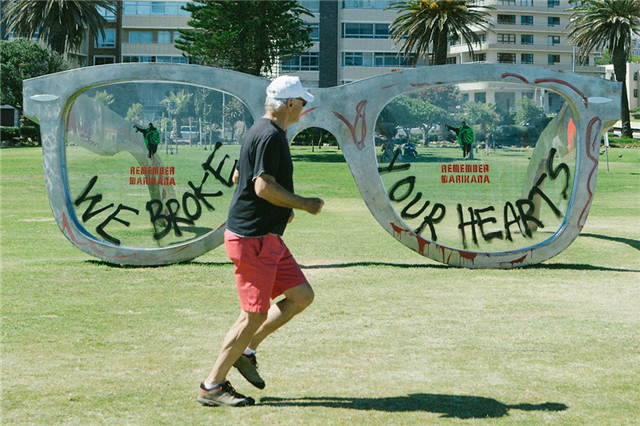
Michael Elion and Tokolos
Perceiving Freedom Tokolos intervention,
.
Photograph
Public art in South Africa is a contested notion. It is, of course, contested everywhere to a greater or lesser extent. In some countries, policy frameworks have been established – the same cannot be said of South Africa since the end of apartheid. Certainly in Cape Town, one of the most culturally diverse and divided cities in the country, public art has been contested to such a degree that no local government has been able to create, let alone deliver on, a formulated policy – although there is one coming.
art events calendar
VIEW FULL CALENDARbuy art prints
edition of 60: R5,000.00
About Editions for ArtThrob
Outstanding prints by top South African artists. Your chance to purchase SA art at affordable prices.
FIND OUT MORE Editions for artthrob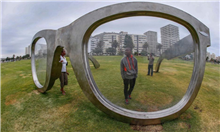
Nic Bothma/EPA
Perceiving Freedom
Photograph
What is surprising about this is that Cape Town’s city centre is perhaps the first post-apartheid metropolis to have become a nominally pedestrian one. Not that Joburg isn’t a city accessed by foot – it is perhaps the most pedestrianised city in South Africa –but pedestrians in Joburg find and make their own paths and create their own ways of negotiating the city ignoring and utilizing planned infrastructure as each person sees fit. In Cape Town, however, certain paths have been constructed to channel and create space for pedestrians and cyclists. And so far it seems to be working. One could mention the huge success of First Thursdays, where literally thousands of people have taken to marauding the pedestrian pathways in search of culture. As such it is surprising that Cape Town is far behind Joburg in having a public arts policy.
Normally with planned pedestrian metropolis, there comes a distinct plan around public arts – a plan the city admits to wanting to begin. However in mentioning this ‘plan,’ one should immediately realize that public art is, to a certain extent, unlike the art that we encounter in galleries, in artists’ studios or in unsanctioned interventions. Public art’s ontology (its nature or defining qualities) is something slightly other than that of the art of the free and independent artist. They are works that the polity recognizes, selects and sanctions as somehow fitting for society. Of course, within a democracy the ethics of this should and must be challenged and weighed against ideas such as ‘freedom of expression’ as well as, on the other side, ‘public taste’ and ‘social morality’. Of course all of these things make public art the contested idea that it is. It is, after all, this contestation and negotiation that are the very fibers of what a liberal democratic society is built upon.
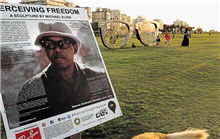
Tom Eaton
Perceiving Freedom information board
Photograph
What then is public art? The philosopher RG Collingwood offered the most interesting clarification as to how public art is distinguishable from the art we encounter in galleries. That is to say that public art has in real terms – because of its relationship to the State – a particular function within society. Collingwood referred to this as ‘magic art’. Under this definition he insisted that magic is the ritualized representation of a ‘useful emotion’ for practical value. His definition of ‘magic’ being a ceremony, sculpture, poem, novel, painting, song, dance or ritual performed or created for social reasons to produce a sense of courage, or pride, or to enforce an idea of hope. Public art or magic art, as Collingwood put it, is closely associated with propaganda and can at times, in the hands of some societies, be a dangerous and divisive tool. It can also, in a democratic state, help to produce a sense of community, civic pride and history.
Under these terms, public art in South Africa should be monitored by the electorate, wary of its negative potential. It should also be put to good use in promoting, within our democracy – hackneyed as such terms are – ideas of ‘nation building’ and ‘social cohesion’. It certainly should always have in mind inclusion and transformation. Public art is, whether we like it or not, the expression of our elected polity, and on these terms is representational of us: South African society and the values of our constitution. What is more, those designated to select public art should always be conscious of the fact that anything sanctioned by government should create a sense of history, inclusion and even, in Collingwood’s terms, an idea of hope for the future.
It is now that we should turn to the infamous glasses that sit on the promenade, created by Ray-Ban and Michael Elion. Where public art’s function in South Africa should, or at least could, be inclusive, the glasses by their very branding as Ray-Ban are exclusive. Perhaps some might suggest that they are a critique of this exclusion but the fact that they are branded and sponsored by Ray-Ban (they are in reality an advert for Ray-Ban) they lose this commentary. As an advert, rather than public art, they come close to aligning government and commercial interests. Something that one would have thought any government, even a neo-liberal one, would be wary of. By allowing advertising to masquerade as public art they open themselves to the criticism that they are too closely linked to big business to serve the people’s interests.

Arttimes
Perceiving Freedom ribbon cutting ceremony
Photograph
But as has been well documented, the glasses and the process of how they ended up on the promenade goes a lot further than merely being an advert. By their creator’s own admission they were an act of opportunism. Michael Elion has admitted openly that his original project did not contain a reference to Mandela. In a recent newspaper article, he mentioned that he tacked on the Mandela reference (without government approval) only after he realized that he could position the glasses, which were originally destined for Camps Bay beach, to face Robben Island. It was only then that the picture of Mandela wearing sunglasses was pulled from the archive to concretize the link and establish the brand association.
Nominally, the work might be seen, with the inclusion of Mandela, as an attempt towards expressing an idea of social cohesion. ‘Think of Mandela, think of freedom, think of our society.’ But there are several problems with this. One is that with the inclusion of Ray-Ban as a sponsor this idea becomes confused. What link does Ray Ban have to Mandela and freedom? Why is contemplating Mandela and freedom through the medium of a pair of Ray-Bans an interesting critique of current South Africa? Of course, our post-apartheid freedom has been distorted by big business and the image of Mandela is all too often used and abused by wealthy corporations to further their own aims, while excluding others. But this is hardly the idea behind ‘Perceiving Freedom’ – the work is far too commercially prescriptive for that. This is not what Ray-Ban and Michael Elion are offering. The work is opportunistic not self-critical.
The incident goes even further than this because we have learnt that the DA’s local government was caught with their pants down, in that quite clearly they did not agree to the project as it stands – they merely agreed to a large set of sunglasses on Camps Bay beach. This potentially shows just how badly run local government is – they have clearly had no oversight over their own project. But they have injured themselves further by showing a lack of accountability, by failing to respond to questions on the matter. On going to press there is still no word from the DA’s Beverly Schafer, the person who chaired the original selection committee, as to whether they had any idea as to what Elion was doing while he unilaterally changed and manipulated the project to his own and Ray-Ban’s ends.
So instead of public art delivering on, or addressing, or critiquing ideas of a social cohesion, of inclusion, of history and of possible hope of unity – it has in this case, delivered on something commercial and divisive. It has exposed the DA to the criticism that, as a party, it is unable to deliver on its promise of transparency and accountability. Although this may all seem like a storm in a Constantia housewife’s teacup, there are important issues at play. As Capetonians we should be very wary as to how our local government represents us. Anything that smacks of political or corporate opportunism and the bulwarking of white and corporate privilege above the concerns of black empowerment should be guarded against – it is a reputation we have already gained and the furtherance of the perception can do us no good.
I personally object to being represented in this manner, particularly by a local government who refuses to be held accountable for their failures of oversight. Furthermore, whether they like it or not, the public art that local government sanctions is an expression of their commitments. If the DA wishes to express themselves through the glasses of ‘Perceiving Freedom’ then it would seem that we are heading further towards the politics of the divided view of the bifocal.

